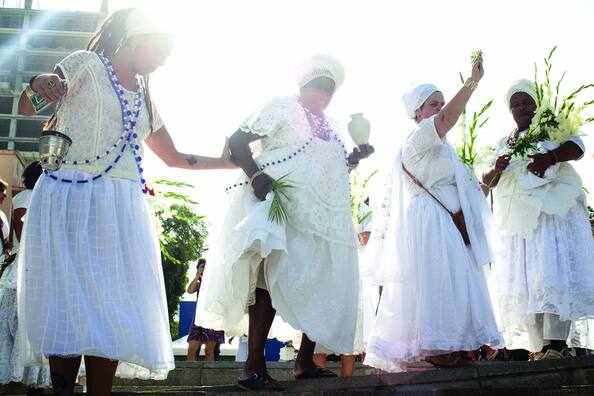Valongo Wharf Archaeological Site
Valongo Wharf Archaeological Site
Valongo Wharf Archaeological Site is located in central Rio de Janeiro and encompasses the entirety of Jornal do Comércio Square. It is in the former harbour area of Rio de Janeiro in which the old stone wharf was built for the landing of enslaved Africans reaching the South American continent from 1811 onwards. An estimated 900,000 Africans arrived in South America via Valongo. The site is composed of several archaeological layers, the lowest of which consists of floor pavings in pé de moleque style, attributed to the original Valongo Wharf. It is the most important physical trace of the arrival of African slaves on the American continent.
Description is available under license CC-BY-SA IGO 3.0
Site archéologique du quai de Valongo
Le Site archéologique du quai de Valongo est situé au centre de Rio de Janeiro. Il englobe l’intégralité de la place du Jornal do Comércio. Il s’agit de l’ancienne zone portuaire de Rio de Janeiro, où fut construit l’ancien quai en pierre, conçu pour le débarquement des esclaves africains atteignant le continent sud-américain à partir de 1811. On estime à 900 000 le nombre d’Africains arrivés en Amérique du Sud par Valongo. Le site est composé de plusieurs couches archéologiques, dont la plus profonde est constituée d’un sol pavé de style pé de moleque, attribué au quai de Valongo d’origine. Il s’agit de la trace matérielle la plus importante associée à l’arrivée d’esclaves africains sur le continent américain.
Description is available under license CC-BY-SA IGO 3.0
موقع رصيف الفالونغو الأثري
يوجد هذا الموقع الأثري في قلب مدينة ريو دي جانيرو. ويمتد على طول موقع Jornal do Comércio بالكامل. ويذكر أنّه كان سابقاً منطقة ميناء في ريو حيث بني رصيف من الحجارة منذ عام 1811 بهدف استقبال العبيد الأفارقة الذين يصلون إلى أمريكا الجنوبيّة. ويقدّر عدد الأفارقة الذين وصلوا إلى الأمريكيّتين عبر هذا الميناء بـ 900 ألف شخص. ويتكوّن الموقع من عدّة طبقات أثريّة تتألف أقدم واحدة منها من أرضية مرصوفة على طراز pé de molequ المستخدم في بناء رصيف الفالونغو الأصلي. ويجسّد هذا الرصيف أحد أهم الآثار الماديّة المرتبطة بقدوم العبيد الأفارقة إلى الأمريكيّتين.
source: UNESCO/CPE
Description is available under license CC-BY-SA IGO 3.0
Sitio arqueológico del muelle de Valongo
Este sitio arqueológico se halla en el centro de Río de Janeiro y abarca la totalidad de la plaza del “Jornal do Comércio”. Ocupa el lugar de la antigua zona portuaria de la ciudad carioca, donde se construyó antaño un muelle de piedra para el atraque de navíos de la trata negrera que transportaban esclavos a Sudamérica. Se cifra en unos 900.000 el número de africanos reducidos a la esclavitud que fueron desembarcados en Valongo. El sitio está integrado por varias capas arqueológicas superpuestas y la más profunda de ellas está formada por una calzada empedrada (“pé de moleque”) perteneciente al muelle de Valongo primigenio. Estos vestigios arqueológicos constituyen la huella física más importante del arribo forzoso de esclavos de África al continente americano.
source: UNESCO/CPE
Description is available under license CC-BY-SA IGO 3.0
Valongo Werf, archaeologische site
De archeologische site Valongo Werf is gelegen in centraal Rio de Janeiro en omvat het hele Jornal do Comércio Plein, het voormalige havengebied van de stad waarin een stenen werf werd gebouwd voor de aankomst van tot slaaf gemaakte Afrikanen. Vanaf 1811 kwam een geschat aantal van 900.000 Afrikanen aan in Zuid-Amerika via Valongo. De fysieke site bestaat uit verschillende archeologische lagen, waarvan de laagstgelegen bestaat uit bestrating in pé de moleque stijl, toegeschreven aan de originele werf. Het is het belangrijkste fysieke spoor van de aankomst van Afrikaanse slaven op het Amerikaanse continent.
Source: unesco.nl
